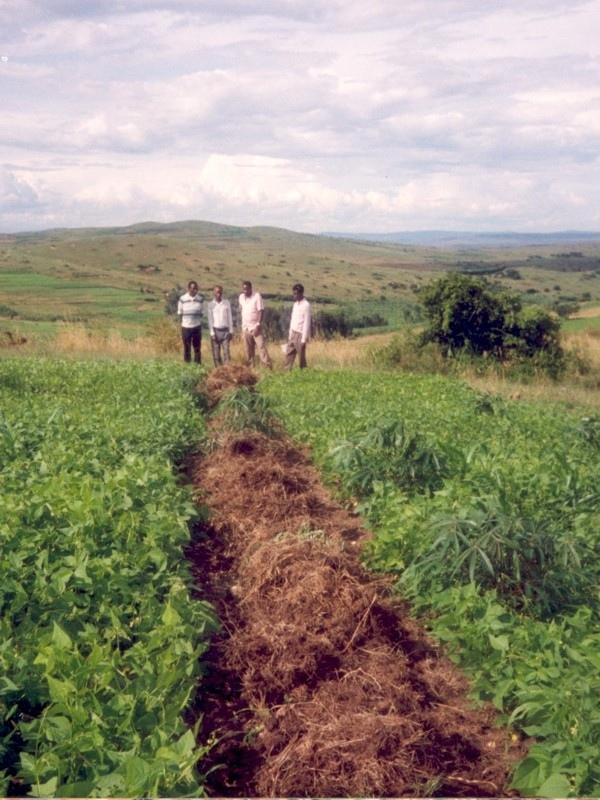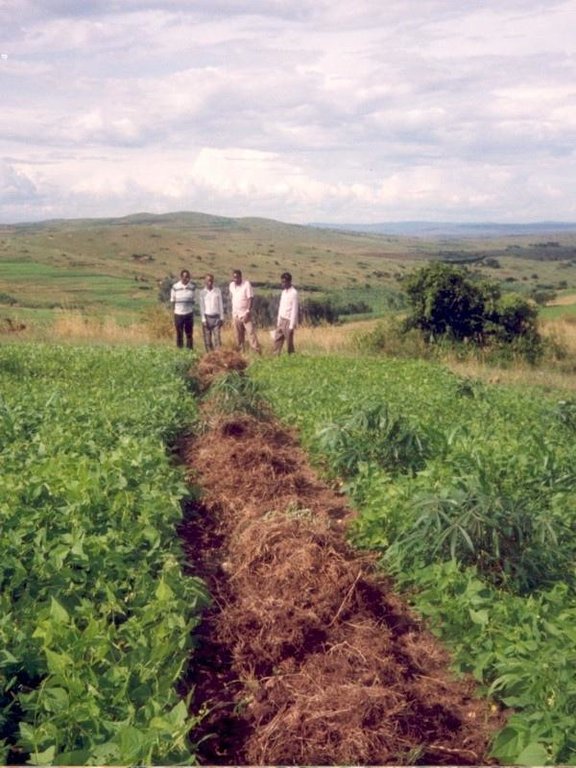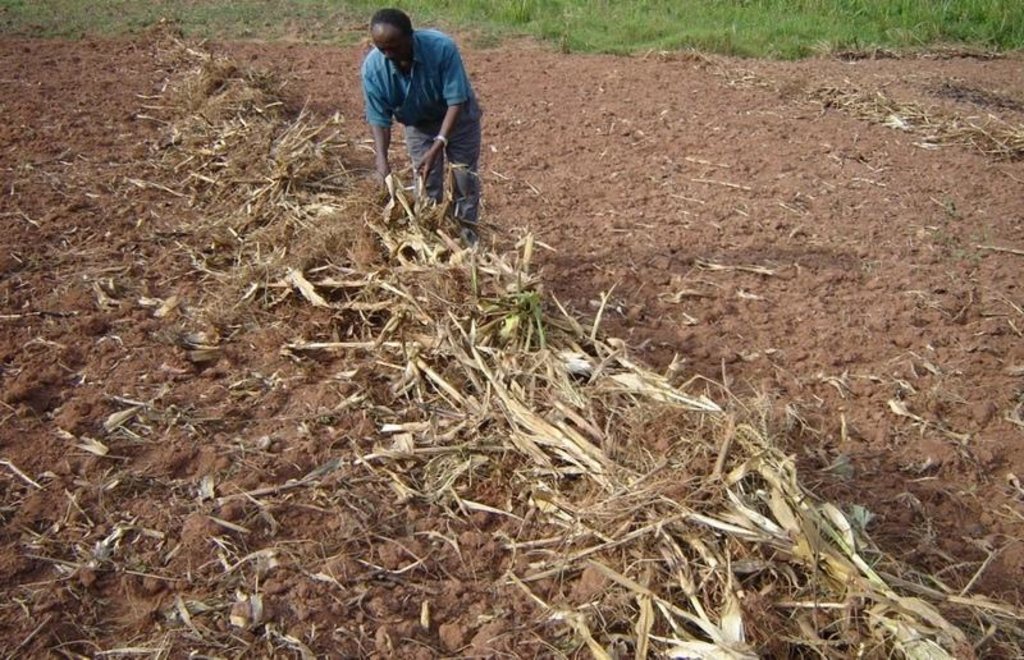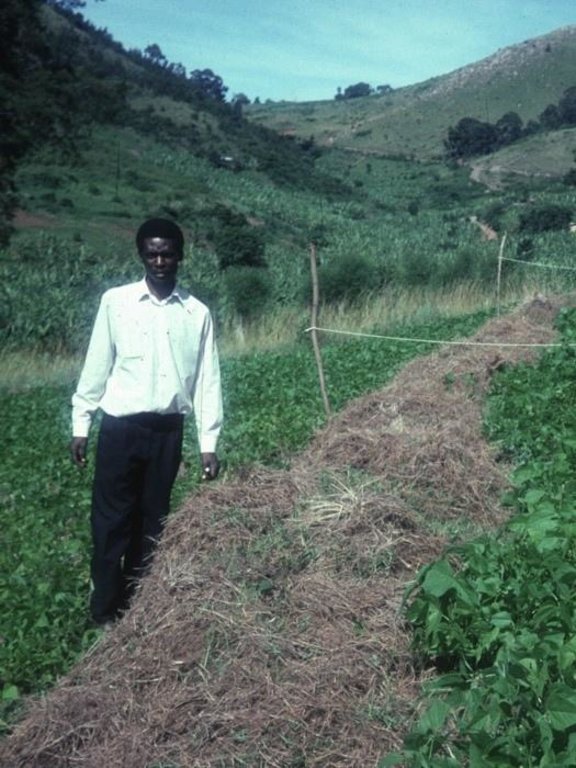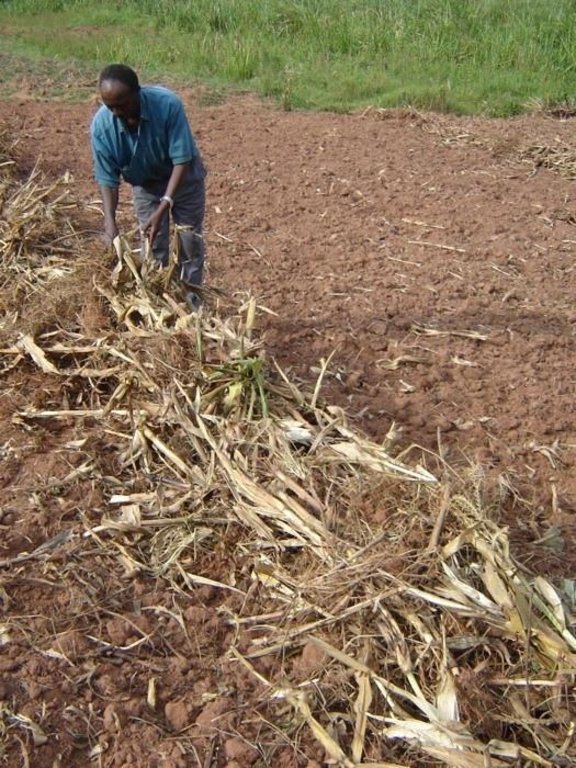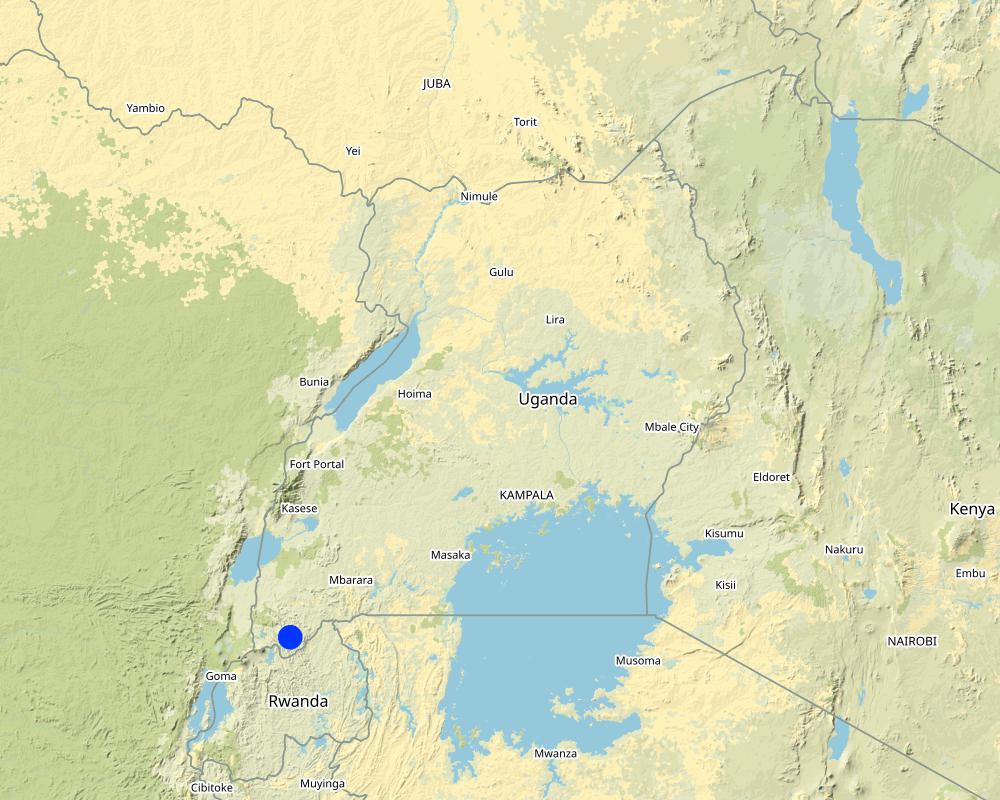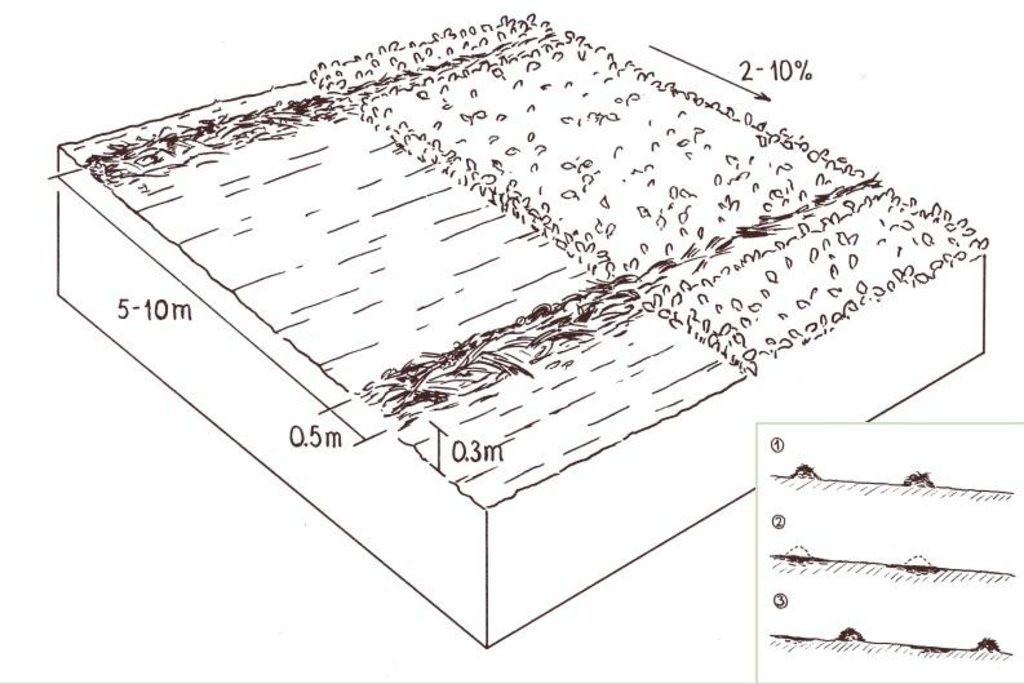Improved trash lines [ยูกันดา]
- ผู้สร้างสรรค์:
- การอัพเดท:
- ผู้รวบรวม: Unknown User
- ผู้เรียบเรียง: –
- ผู้ตรวจสอบ: Alexandra Gavilano, Fabian Ottiger, Joana Eichenberger
Emikikizo (Lukiga)
technologies_990 - ยูกันดา
ดูส่วนย่อย
ขยายทั้งหมด ย่อทั้งหมด1. ข้อมูลทั่วไป
1.2 รายละเอียดที่ติดต่อได้ของผู้รวบรวมและองค์กรที่เกี่ยวข้องในการประเมินและการจัดเตรียมทำเอกสารของเทคโนโลยี
วิทยากรหลัก
ผู้เชี่ยวชาญ SLM:
Miiro Henry Dan
Ministry of agriculture animal industry and fisheries - Uganda
ยูกันดา
ชื่อของโครงการซึ่งอำนวยความสะดวกในการทำเอกสารหรือการประเมินเทคโนโลยี (ถ้าเกี่ยวข้อง)
Book project: where the land is greener - Case Studies and Analysis of Soil and Water Conservation Initiatives Worldwide (where the land is greener)ชื่อขององค์กรซึ่งอำนวยความสะดวกในการทำเอกสารหรือการประเมินเทคโนโลยี (ถ้าเกี่ยวข้อง)
Ministry of Agriculture, Animal Industry, and Fisheries of Uganda (MAAIF) - ยูกันดา1.3 เงื่อนไขการใช้ข้อมูลที่ได้บันทึกผ่านทาง WOCAT
ผู้รวบรวมและวิทยากรหลักยอมรับเงื่อนไขเกี่ยวกับการใช้ข้อมูลที่ถูกบันทึกผ่านทาง WOCAT:
ใช่
1.5 Reference to Questionnaire(s) on SLM Approaches (documented using WOCAT)
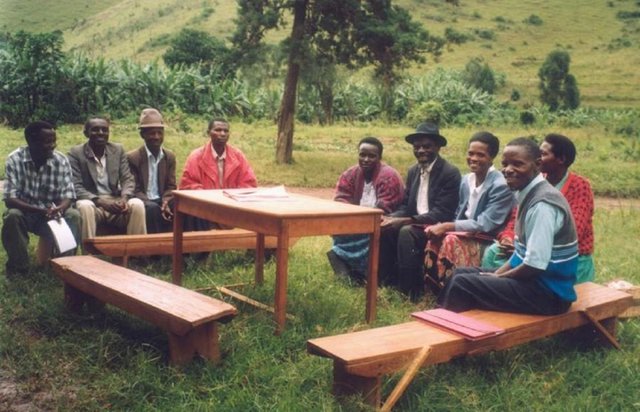
Promoting farmer innovation [ยูกันดา]
Identification of farmer innovators in SWC and water harvesting, and using them as focal points for visits from other farmers to spread the practices and stimulate the process of innovation.
- ผู้รวบรวม: Kithinji Mutunga
2. การอธิบายลักษณะของเทคโนโลยี SLM
2.1 การอธิบายแบบสั้น ๆ ของเทคโนโลยี
คำจำกัดความของเทคโนโลยี:
Weeds and crop residues laid in bands across the slope of annual crop fields to conserve soil and water, and to incorporate organic matter into the soil after decomposition.
2.2 การอธิบายแบบละเอียดของเทคโนโลยี
คำอธิบาย:
Trash lines of organic material across the slope constitute a traditional land husbandry practice in south-west Uganda. These traditional, ‘unimproved’, trash lines are beneficial, but even better is an improved version designed through Participatory Technology Development (PTD). Improved trash lines are smaller, closer spaced, and of longer duration than the traditional type. They are more effective in controlling runoff and maintaining soil fertility.
All trash lines (improved and traditional) are composed of cereal stover (straw) and weeds that are collected during primary cultivation (hand hoeing), and heaped in strips along the approximate contour. Creeping grasses should not be used in trash lines: they can alternatively be decomposed in bundles, and then used as mulch in nearby banana plantations. Trash lines are used in hillside fields where annual crops, including sorghum, finger millet, beans and peas, are grown. The recommended spacing between the improved trash lines is 5-10 m, depending
on the slope: the steeper the closer. The amount of material available determines the cross section of each trash line (typically ±0.5 m wide and ±0.3 m high). Improved trash lines are left in place for four seasons (there are two seasons a year in Kabale) before they are dug into the soil. Much of the material used has, by this time, decomposed or been eaten by termites. Through incorporation into the topsoil, they improve soil fertility acting effectively as ‘mobile compost strips’. New trash lines are then established between the sites of the former lines. Upkeep comprises removal of weeds that sprout within the lines - before they set seed - and the addition of more trash during each new cultivation and weeding cycle.
Improved trash lines are multipurpose in retarding dispersed runoff while, as discussed, maintaining soil fertility. They are a low-cost option for soil and water conservation. However, they need to be complemented by other measures on the steeper slopes. The climate in this part of Uganda is subhumid, with a bimodal rainfall regime, and average annual rainfall of around 800 mm. Hill tops are used for grazing, the lower slopes are cultivated with annual crops (where the trash lines are found) and the valleys are dedicated to bananas and other cash crops. Families are large: 8-10 persons, and the population density is high, at nearly 200 persons/km2.
2.3 รูปภาพของเทคโนโลยี
2.5 ประเทศภูมิภาค หรือสถานที่ตั้งที่เทคโนโลยีได้นำไปใช้และได้รับการครอบคลุมโดยการประเมินนี้
ประเทศ:
ยูกันดา
ภูมิภาค/รัฐ/จังหวัด:
Kabale
ข้อมูลจำเพาะเพิ่มเติมของสถานที่ตั้ง :
Kabale district
ระบุการกระจายตัวของเทคโนโลยี:
- กระจายไปอย่างสม่ำเสมอในพื้นที่
If precise area is not known, indicate approximate area covered:
- 0.1-1 ตร.กม.
แสดงความคิดเห็น:
Total area covered by the SLM Technology is 0.25 km2.
it is an indeginous technology. Widely used in various fields and at different slopes.
Map
×2.6 วันที่การดำเนินการ
ถ้าไม่รู้ปีที่แน่นอน ให้ระบุวันที่โดยประมาณ:
- มากกว่า 50 ปี (แบบดั้งเดิม)
2.7 คำแนะนำของเทคโนโลยี
ให้ระบุว่าเทคโนโลยีถูกแนะนำเข้ามาอย่างไร:
- เป็นส่วนหนึ่งของระบบแบบดั้งเดิมที่ทำก้นอยู่ (> 50 ปี)
3. การจัดประเภทของเทคโนโลยี SLM
3.1 วัตถุประสงค์หลักของเทคโนโลยี
- ปรับปรุงการผลิตให้ดีขึ้น
- ลด ป้องกัน ฟื้นฟู การเสื่อมโทรมของที่ดิน
- ปรับตัวเข้ากับการเปลี่ยนแปลงภูมิอากาศของโลก สภาพภูมิอากาศที่รุนแรงและผลกระทบ
3.2 ประเภทของการใช้ที่ดินในปัจจุบันที่ได้นำเทคโนโลยีไปใช้

พื้นที่ปลูกพืช
- การปลูกพืชล้มลุกอายุปีเดียว
- การปลูกพืชยืนต้นที่ไม่มีเนื้อไม้
- การปลูกไม้ยืนต้น ไม้พุ่ม
Annual cropping - Specify crops:
- cereals - millet
- cereals - sorghum
- legumes and pulses - beans
- legumes and pulses - peas
Perennial (non-woody) cropping - Specify crops:
- banana/plantain/abaca
- Eucalyptus
จำนวนของฤดูเพาะปลูกต่อปี:
- 2
ระบุ:
Longest growing period in days: 180 Longest growing period from month to month: Feb - Jul Second longest growing period in days: 120 Second longest growing period from month to month: Sep - Jan
แสดงความคิดเห็น:
Major land use problems (compiler’s opinion): Continuous cultivation of annual crops on slopes prone to erosion, with little or no restitution of fertility through manures
or fertilizers.
Major land use problems (land users’ perception): continous cultivation without fallow due to small sizes of farms
3.4 การใช้น้ำ
การใช้น้ำของที่ดินที่มีการใช้เทคโนโลยีอยู่:
- จากน้ำฝน
3.5 กลุ่ม SLM ที่ตรงกับเทคโนโลยีนี้
- การปรับปรุงดิน / พืชคลุมดิน
- มาตรการปลูกพืชขวางความลาดชัน (cross-slope measure)
- การเก็บเกี่ยวน้ำ
3.6 มาตรการ SLM ที่ประกอบกันเป็นเทคโนโลยี
3.7 รูปแบบหลักของการเสื่อมโทรมของที่ดินที่ได้รับการแก้ไขโดยเทคโนโลยี

การกัดกร่อนของดินโดยน้ำ
- Wt (Loss of topsoil): การสูญเสียดินชั้นบนหรือการกัดกร่อนที่ผิวดิน

การเสื่อมโทรมของดินทางด้านเคมี
- Cn (Fertility decline): ความอุดมสมบูรณ์และปริมาณอินทรียวัตถุในดินถูกทำให้ลดลงไป (ไม่ได้เกิดจากสาเหตุการกัดกร่อน)

การเสื่อมโทรมของน้ำ
- Ha (Aridification): การเกิดความแห้งแล้ง
แสดงความคิดเห็น:
Main type of degradation addressed: Wt: loss of topsoil / surface erosion, Cn: fertility decline and reduced organic matter content
Main causes of degradation: other human induced causes (specify) (lack of communication), education, access to knowledge and support services (lack of spread of knowledge)
3.8 การป้องกัน การลดลง หรือการฟื้นฟูความเสื่อมโทรมของที่ดิน
ระบุเป้าหมายของเทคโนโลยีกับความเสื่อมโทรมของที่ดิน:
- ป้องกันความเสื่อมโทรมของที่ดิน
- ลดความเสื่อมโทรมของดิน
แสดงความคิดเห็น:
Main goals: mitigation / reduction of land degradation
Secondary goals: prevention of land degradation
4. ข้อมูลจำเพาะด้านเทคนิค กิจกรรมการนำไปปฏิบัติใช้ ปัจจัยนำเข้า และค่าใช้จ่าย
4.1 แบบแปลนทางเทคนิคของเทคโนโลยี
ข้อมูลจำเพาะด้านเทคนิค (แบบแปลนทางเทคนิคของเทคโนโลยี):
Trash lines without crops (left)
and with crops (beans; right).
The insert shows the stages of the technology: regularly spaced trash lines are kept place for four seasons (1); then decompose over time and are incorporated into the soil (2); and finally new trash lines are placed between the previous strips (3).
Technical knowledge required for field staff / advisors: low
Technical knowledge required for land users: low
Main technical functions: control of dispersed runoff: impede / retard, increase of infiltration, increase in soil fertility
Secondary technical functions: control of dispersed runoff: retain / trap, increase in organic matter, improvement of soil structure, sediment harvesting
Agronomic measure: mulching, trash lines
Material/ species: weed residue, sorghum
Remarks: along contour
ผู้เขียน:
Mats Gurtner
4.2 ข้อมูลทั่วไปเกี่ยวกับการคำนวณปัจจัยนำเข้าและค่าใช้จ่าย
อื่นๆ หรือสกุลเงินประจำชาติ (ระบุ):
Uganda Shillings
If relevant, indicate exchange rate from USD to local currency (e.g. 1 USD = 79.9 Brazilian Real): 1 USD =:
1000.0
ระบุค่าเฉลี่ยของค่าจ้างในการจ้างแรงงานต่อวัน:
1.00
4.4 ค่าใช้จ่ายของปัจจัยนำเข้าที่จำเป็นสำหรับการจัดตั้ง
| ปัจจัยนำเข้า | หน่วย | ปริมาณ | ค่าใช้จ่ายต่อหน่วย | ค่าใช้จ่ายทั้งหมดต่อปัจจัยนำเข้า | %ของค่าใช้จ่ายที่ก่อให้เกิดขึ้นโดยผู้ใช้ที่ดิน | |
|---|---|---|---|---|---|---|
| แรงงาน | Labour | ha | 1.0 | 25.0 | 25.0 | 100.0 |
| อุปกรณ์ | Tools | ha | 1.0 | 5.0 | 5.0 | 100.0 |
| ค่าใช้จ่ายทั้งหมดของการจัดตั้งเทคโนโลยี | 30.0 | |||||
| Total costs for establishment of the Technology in USD | 0.03 | |||||
แสดงความคิดเห็น:
Duration of establishment phase: 36 month(s)
4.5 การบำรุงรักษาสภาพหรือกิจกรรมที่เกิดขึ้นเป็นประจำ
| กิจกรรม | ช่วงระยะเวลา/ความถี่ | |
|---|---|---|
| 1. | During land cultivation, existing (old) trash lines are dug. 2. New trash lines are then created exactly between the (cross-slope) | Dry season / each cropping season |
| 2. | The size of the trash lines depends on the amount of trash available, | Dry season |
| 3. | Weeds are added to the trash lines, and, in preparation for the second | Second season |
| 4. | Trash lines are kept free of growing weeds and built up with more | Third and fourth seasons |
| 5. | Trash lines are kept free of growing weeds and built up with moretrash. Full cycle for improved trash lines: 4 seasons (2 years) |
4.6 ค่าใช้จ่ายของปัจจัยนำเข้าและกิจกรรมที่เกิดขึ้นเป็นประจำที่ต้องการการบำรุงรักษา (ต่อปี)
แสดงความคิดเห็น:
Machinery/ tools: hand hoe
These figures are approximate, representing a typical situation with 1,500 running metres of improved trash lines, per hectare, at a spacing of 7 m apart on a 10% slope. The 1st year (first and second seasons) involves more work than the
2nd year (third and fourth seasons): the figure given is an annual average of all work associated with trash lines. The costs of the traditional, larger and wider spaced trash lines are about 50% more than these given above - because trash has to be carried further.
4.7 ปัจจัยสำคัญที่สุดที่มีผลกระทบต่อค่าใช้จ่าย
ปัจจัยสำคัญที่สุดที่มีผลกระทบต่อค่าใช้จ่ายต่างๆ:
Labour, need to collect and heap the trashlines material in lines above the slope
5. สิ่งแวดล้อมทางธรรมชาติและของมนุษย์
5.1 ภูมิอากาศ
ฝนประจำปี
- < 250 ม.ม.
- 251-500 ม.ม.
- 501-750 ม.ม.
- 751-1,000 ม.ม.
- 1,001-1,500 ม.ม.
- 1,501-2,000 ม.ม.
- 2,001-3,000 ม.ม.
- 3,001-4,000 ม.ม.
- > 4,000 ม.ม.
ระบุปริมาณน้ำฝนเฉลี่ยรายปี (ถ้ารู้) :หน่วย ม.ม.
800.00
เขตภูมิอากาศเกษตร
- กึ่งชุ่มชื้น
Thermal climate class: tropics
5.2 สภาพภูมิประเทศ
ค่าเฉลี่ยความลาดชัน:
- ราบเรียบ (0-2%)
- ลาดที่ไม่ชัน (3-5%)
- ปานกลาง (6-10%)
- เป็นลูกคลื่น (11-15%)
- เป็นเนิน (16-30%)
- ชัน (31-60%)
- ชันมาก (>60%)
ธรณีสัณฐาน:
- ที่ราบสูง/ที่ราบ
- สันเขา
- ไหล่เขา
- ไหล่เนินเขา
- ตีนเนิน
- หุบเขา
ระดับความสูง:
- 0-100 เมตร
- 101-500 เมตร
- 501-1,000 เมตร
- 1,001-1,500 เมตร
- 1,501-2,000 เมตร
- 2,001-2,500 เมตร
- 2,501-3,000 เมตร
- 3,001-4,000 เมตร
- > 4,000 เมตร
ความคิดเห็นและข้อมูลจำเพาะเพิ่มเติมเรื่องสภาพภูมิประเทศ:
Slopes on average: Also rolling and hilling (both ranked 2)
5.3 ดิน
ค่าเฉลี่ยความลึกของดิน:
- ตื้นมาก (0-20 ซ.ม.)
- ตื้น (21-50 ซ.ม.)
- ลึกปานกลาง (51-80 ซ.ม.)
- ลึก (81-120 ซ.ม.)
- ลึกมาก (>120 ซ.ม.)
เนื้อดิน (ดินชั้นบน):
- ปานกลาง (ดินร่วน ทรายแป้ง)
อินทรียวัตถุในดิน:
- ปานกลาง (1-3%)
- ต่ำ (<1%)
(ถ้ามี) ให้แนบคำอธิบายเรื่องดินแบบเต็มหรือระบุข้อมูลที่มีอยู่ เช่น ชนิดของดิน ค่า pH ของดินหรือความเป็นกรดของดิน ความสามารถในการแลกเปลี่ยนประจุบวก ไนโตรเจน ความเค็ม เป็นต้น:
Soil texture: Medium (the trash material modifies the organic matter content of the areas applied)
Soil fertility: Medium (ranked 1) and low (ranked 2)
Soil drainage/infiltration: Medium
Soil water storage capacity: Low (ranked 1) and medium (ranked 2)
5.6 ลักษณะของผู้ใช้ที่ดินที่นำเทคโนโลยีไปปฏิบัติใช้
แนวทางการตลาดของระบบการผลิต:
- เพื่อการยังชีพ (หาเลี้ยงตนเอง)
- mixed (subsistence/ commercial)
รายได้ที่มาจากนอกฟาร์ม:
- 10-50% ของรายได้ทั้งหมด
ระดับของความมั่งคั่งโดยเปรียบเทียบ:
- จน
- พอมีพอกิน
ระดับของการใช้เครื่องจักรกล:
- งานที่ใช้แรงกาย
ระบุลักษณะอื่นๆที่เกี่ยวข้องของผู้ใช้ที่ดิน:
1% of the land users are very rich and own 5% of the land.
5% of the land users are rich and own 10% of the land.
24% of the land users are average wealthy and own 50% of the land.
55% of the land users are poor and own 25% of the land.
Off-farm income specification: some farmers are involved in trade with nearby Rwanda and there are also a number of families who receive remittances from family members who work in Kabale or as far away as Kampala
5.7 Average area of land used by land users applying the Technology
- < 0.5 เฮกตาร์
- 0.5-1 เฮกตาร์
- 1-2 เฮกตาร์
- 2-5 เฮกตาร์
- 5-15 เฮกตาร์
- 15-50 เฮกตาร์
- 50-100 เฮกตาร์
- 100-500 เฮกตาร์
- 500-1,000 เฮกตาร์
- 1,000-10,000 เฮกตาร์
- >10,000 เฮกตาร์
แสดงความคิดเห็น:
Average area of land owned or leased by land users applying the Technology: Also 1-2 ha (ranked 2) and 2-5 ha (ranked 3)
5.8 กรรมสิทธิ์ในที่ดิน สิทธิในการใช้ที่ดินและสิทธิในการใช้น้ำ
กรรมสิทธิ์ในที่ดิน:
- รายบุคคล ไม่ได้รับสิทธิครอบครอง
สิทธิในการใช้ที่ดิน:
- เกี่ยวกับชุมชน (ถูกจัดระเบียบ)
- รายบุคคล
6. ผลกระทบและสรุปคำบอกกล่าว
6.4 การวิเคราะห์ค่าใช้จ่ายและผลประโยชน์ที่ได้รับ
ผลประโยชน์ที่ได้รับเปรียบเทียบกับค่าใช้จ่ายในการบำรุงรักษาหรือต้นทุนที่เกิดขึ้นซ้ำอีก เป็นอย่างไร (จากมุมมองของผู้ใช้ที่ดิน)
ผลตอบแทนระยะสั้น:
ด้านบวก
ผลตอบแทนระยะยาว:
ด้านบวกอย่างมาก
6.5 การปรับตัวของเทคโนโลยี
แสดงความคิดเห็น:
30 land user families have adopted the Technology without any external material support
Comments on spontaneous adoption: estimates
There is a moderate trend towards spontaneous adoption of the Technology
Comments on adoption trend: the technology is indeginous. There is some evidence of growing spontaneous adoption.
6.7 จุดแข็ง / ข้อได้เปรียบ / โอกาสของเทคโนโลยี
| จุดแข็ง / ข้อได้เปรียบ / โอกาสในทัศนคติของผู้ใช้ที่ดิน |
|---|
|
Improved trash lines have small but significant advantages over the traditional trash lines (which are beneficial themselves) in terms of (a) less labour (b) improved crop performance How can they be sustained / enhanced? Continue with farmer-to-farmer visits for this to be explained. |
| จุดแข็ง / ข้อได้เปรียบ / โอกาสในทัศนคติของผู้รวบรวมหรือวิทยากรหลัก |
|---|
|
The technology is very simple and uses locally available material. It is easy to understand, being a modification of an existing tradition How can they be sustained / enhanced? Continue with farmer-to-farmer visits for first hand learning. |
|
Multiple ecological and SWC benefits: improves soil fertility, reduces erosion, increases infiltration etc How can they be sustained / enhanced? Continue to encourage adoption of (and further farmer experimentation with) the improved trash lines. |
6.8 จุดอ่อน / ข้อเสียเปรียบ / ความเสี่ยงของเทคโนโลยีและวิธีการแก้ไข
| จุดอ่อน / ข้อเสียเปรียบ / ความเสี่ยงในทัศนคติของผู้ใช้ที่ดิน | มีวิธีการแก้ไขได้อย่างไร |
|---|---|
| Source of weeds | Pull out weeds before they set seed and don’t use stoloniferous or rhizome-forming (creeping) grasses in trash lines (see picture). |
| trash line harbours pest and diseases | use entirely dry grass or material |
| จุดอ่อน / ข้อเสียเปรียบ / ความเสี่ยงในทัศนคติของผู้รวบรวมหรือวิทยากรหลัก | มีวิธีการแก้ไขได้อย่างไร |
|---|---|
| Where land is limiting, agricultural land which would be used, is lost | uses it as a crop rotation basis |
| The trash lines are not enough on their own to control erosion on the steeper slopes | Introduce/promote supplementary structural remedies such as earth bunds. |
| Competition for crop residues which have an alternative use as livestock fodder and, especially, mulch in banana plantations | Grow hedgerows of shrubs/grasses to increase availability of material for fodder, trash lines and mulching. |
7. การอ้างอิงและการเชื่อมต่อ
7.1 วิธีการและแหล่งข้อมูล
7.2 การอ้างอิงถึงสิ่งตีพิมพ์
หัวข้อ, ผู้เขียน, ปี, หมายเลข ISBN:
Briggs SR et al. Livelihoods in Kamwezi, Kabale District, Uganda.. 1998.
ชื่อเรื่อง ผู้เขียน ปี ISBN:
Silsoe Research Institute, UK
หัวข้อ, ผู้เขียน, ปี, หมายเลข ISBN:
Mutunga K and Critchley W. Farmer’s initiatives in land husbandry Technical Report No 27. 2001.
ชื่อเรื่อง ผู้เขียน ปี ISBN:
Regional Land Management Unit, Nairobi, Kenya
หัวข้อ, ผู้เขียน, ปี, หมายเลข ISBN:
Critchley W and Mutunga K .Local innovation in a global context: documenting farmer initiatives in land husbandry through WOCAT Land Degradation and Development (14) pp 143–162. 2003.
ลิงก์และโมดูล
ขยายทั้งหมด ย่อทั้งหมดลิงก์

Promoting farmer innovation [ยูกันดา]
Identification of farmer innovators in SWC and water harvesting, and using them as focal points for visits from other farmers to spread the practices and stimulate the process of innovation.
- ผู้รวบรวม: Kithinji Mutunga
โมดูล
ไม่มีโมดูล


